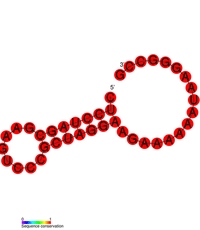Closterovirus
Closterovirus, also known as beet yellows viral group, is a genus of viruses, in the family Closteroviridae. Plants serve as natural hosts. There are currently 16 species in this genus. Diseases associated with this genus include: yellowing and necrosis, particularly affecting the phloem.[1][2] This genus has a probably worldwide distribution and includes among other viral species the Beet yellows virus (the type species) and Citrus tristeza virus, rather economically important plant diseases. At least some species require vectors such as aphids or mealybugs for their transmission from plant to plant.[3]
| Closterovirus | |
|---|---|
| Virus classification | |
| (unranked): | Virus |
| Realm: | Riboviria |
| Kingdom: | Orthornavirae |
| Phylum: | Kitrinoviricota |
| Class: | Alsuviricetes |
| Order: | Martellivirales |
| Family: | Closteroviridae |
| Genus: | Closterovirus |
| Type species | |
| Beet yellows virus | |
| 3'-terminal pseudoknot in BYV | |
|---|---|
 Predicted secondary structure of the 3'-terminal pseudoknot in BYV | |
| Identifiers | |
| Rfam | RF01100 |
| Other data | |
| RNA type | Cis-reg |
| Domain(s) | Closterovirus |
| PDB structures | PDBe |
RNA pseudoknot
The viral RNA molecules of some members of this genus contain four hair-pin structures and a pseudoknot in the 3'UTR.[4] These secondary structures have been found to be important in viral RNA replication.[5]
Life cycle
Viral replication is cytoplasmic. Entry into the host cell is achieved by penetration into the host cell. Replication follows the positive stranded RNA virus replication model. Positive stranded rna virus transcription is the method of transcription. The virus exits the host cell by tubule-guided viral movement. Plants serve as the natural host. Transmission routes are mechanical.[1]
| Genus | Host details | Tissue tropism | Entry details | Release details | Replication site | Assembly site | Transmission |
|---|---|---|---|---|---|---|---|
| Closterovirus | Plants | None | Viral movement; mechanical inoculation | Viral movement | Cytoplasm | Cytoplasm | Mechanical inoculation: insects |
Structure
Viruses in Closterovirus are non-enveloped, with flexuous and Filamentous geometries. The diameter is around 10-13 nm, with a length of 1250-2200 nm. Genomes are linear, around 19.3kb in length.[1]
| Genus | Structure | Symmetry | Capsid | Genomic arrangement | Genomic segmentation |
|---|---|---|---|---|---|
| Closterovirus | Filamentous | Non-enveloped | Linear | Monopartite |
Taxonomy
Group: ssRNA(+)
- Family: Closteroviridae
- Genus: Closterovirus
- Arracacha virus 1
- Beet yellow stunt virus
- Beet yellows virus
- Blackcurrant closterovirus 1
- Burdock yellows virus
- Carnation necrotic fleck virus
- Carrot yellow leaf virus
- Citrus tristeza virus
- Grapevine leafroll-associated virus 2
- Mint virus 1
- Raspberry leaf mottle virus
- Rehmannia virus 1
- Rose leaf rsoetta-associated virus
- Strawberry chlorotic fleck-associated virus
- Tobacco virus 1
- Wheat yellow leaf virus
References
- "Viral Zone". ExPASy. Retrieved 15 June 2015.
- ICTV. "Virus Taxonomy: 2014 Release". Retrieved 15 June 2015.
- "ICTVdB Virus Description - 00.017.0.01. Closterovirus".
- Livieratos IC, Eliasco E, Müller G, et al. (July 2004). "Analysis of the RNA of Potato yellow vein virus: evidence for a tripartite genome and conserved 3'-terminal structures among members of the genus Crinivirus". J. Gen. Virol. 85 (Pt 7): 2065–75. doi:10.1099/vir.0.79910-0. PMID 15218192.
- Satyanarayana T, Gowda S, Ayllón MA, Albiach-Martí MR, Dawson WO (August 2002). "Mutational analysis of the replication signals in the 3'-nontranslated region of citrus tristeza virus". Virology. 300 (1): 140–52. doi:10.1006/viro.2002.1550. PMID 12202214.